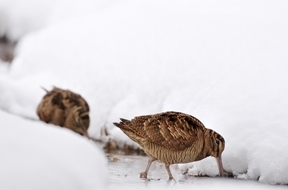 With the cold weather approaching, now is the time to be mindful of your resident woodcock numbers and consider how you are going to help them this winter.
With the cold weather approaching, now is the time to be mindful of your resident woodcock numbers and consider how you are going to help them this winter.
Current evidence suggests that over 90% of woodcock shot here migrate from Europe, where breeding numbers appear stable. Resident British woodcock are thought to have increased in abundance and range since the 19th Century until about the early 1970s. However, subsequent range contraction was detected between 1970 and 1990, and further range contraction and population decline has become evident in many parts of Britain and Ireland since.
Andrew Hoodless from Game & Wildlife Conservation Trust says “With studies not yet complete we currently cannot rule out shooting as a factor in the decline of our resident woodcock.” Andrew continues “As a result, we are advising all those who intend to shoot woodcock to take extra caution if they are known to breed in the locality and to start improving their knowledge of the local woodcock population by counting roding males in spring.”
By taking on the following advice you will be effectively helping your resident woodcock.
Curb shooting in cold weather
We are currently conducting research to better understand the effect of cold weather on woodcock. However, every effort should be made to reduce additional mortality when woodcock are at higher risk of starvation and predation during cold spells. We are aware that most shoots stop shooting woodcock before a statutory cold weather suspension comes into force after 13 days. Our current advice is that woodcock shooting should stop after seven days with daily temperatures below 0°C or with the onset of lying snow and that birds should be given a chance to recover for at least a week following such weather.
Show restraint even where resident birds are absent
Restraint when shooting woodcock makes sense even in areas where there are no local breeders, because we know from our satellite tracking and annual ringing of woodcock that the majority of migrant woodcock are extremely faithful to the same wintering site year on year. Overshooting will therefore break the migratory link with your shoot and is likely to lead to fewer woodcock being seen in future.
Shoot flight lines with caution
We urge local caution when shooting woodcock flighting from woodland at dusk owing to a higher risk of overshooting.
Important new resident woodcock project
GWCT is currently conducting research to get a better insight into why our resident woodcock population is in decline. The woodcock team are now preparing to catch, ring and attach GPS tracking devices to a further 35 birds across the UK in order to monitor resident birds’ breeding behaviour and habitat use. You can help us understand the decline and devise solutions by making a donation at www.gwct.org.uk/woodcock2016
Notes
1, C. Heward, A. Hoodless, G. Conway, N. Aebischer, S. Gillings & R. Fuller (2015) Current status and recent trend of the Eurasian Woodcock Scolopax rusticola as a breeding bird in Britain
2, Woodcock Factsheet - http://www.gwct.org.uk/media/552832/Woodcock-fact-sheet.pdf
Photo Credit- Laurie Campbell
Notes to editors
The Game & Wildlife Conservation Trust – providing research-led conservation for a thriving countryside. The GWCT is an independent wildlife conservation charity which has carried out scientific research into Britain’s game and wildlife since the 1930s. We advise farmers and landowners on improving wildlife habitats. We employ more than 60 post-doctoral scientists and other research staff with expertise in areas such as birds, insects, mammals, farming, fish and statistics. We undertake our own research as well as projects funded by contract and grant-aid from government and private bodies.
For information, contact:
Eleanor Williams
Telephone: 07592 025476
Email: press@gwct.org.uk